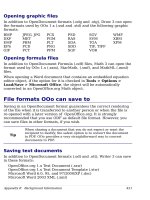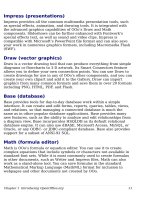Getting Started with Open Office .org 3 part 9 pot
Bạn đang xem bản rút gọn của tài liệu. Xem và tải ngay bản đầy đủ của tài liệu tại đây (4.76 MB, 10 trang )
Chapter 4
Getting Started with Writer
Word processing with OpenOffice.org
What is Writer?
Writer is the word processor component of OpenOffice.org (OOo). In
addition to the usual features of a word processor (spell checking,
thesaurus, hyphenation, autocorrect, find and replace, automatic
generation of tables of contents and indexes, mail merge and others),
Writer provides these important features:
• Templates and styles (see Chapter 3)
• Powerful page layout methods, including frames, columns, and
tables
• Embedding or linking of graphics, spreadsheets, and other
objects
• Built-in drawing tools
• Master documents—to group a collection of documents into a
single document
• Change tracking during revisions
• Database integration, including a bibliography database
• Export to PDF, including bookmarks (see Chapter 10)
• And many more
These features are covered in detail in the
Writer Guide
.
The Writer interface
The main Writer workspace is shown in Figure 53. The menus and
toolbars are described in Chapter 1 (Introducing OpenOffice.org).
Some other features of the Writer interface are covered in this chapter.
Figure 53: The main Writer workspace in Print
Layout view
82 Getting Started with OpenOffice.org 3
Status bar
The Writer status bar provides information about the document and
convenient ways to quickly change some document features. From left
to right, the fields are as follows.
Page number
Shows the current page number, the sequence number of the
current page (if different), and the total number of pages in the
document. For example, if you restarted page numbering at 1 on the
third page, its page number is 1 and its sequence number is 3.
To jump to the location of a bookmark, right-click on this field. A list
of bookmarks pops up; click on the required one.
To jump to a specific page in the document, double-click in this field.
The Navigator opens. Click in the Page Number field and type the
required page number.
Page style
Shows the style of the current page. To change the page style, right-
click on this field. A list of page styles pops up; choose a different
style by clicking on it.
To edit the page style, double-click on this field. The Page Style
dialog opens.
Language
Shows the language for the selected text.
Click to open a menu where you can choose another language for
the selected text or for the paragraph where the cursor is located.
You can also choose None to exclude the text from spellchecking or
choose More to open the Character dialog.
Insert mode
Click to toggle between
Insert
and
Overwrite
modes when typing.
Selection mode
Click to toggle between STD (
Standard
), EXT (
Extend
), ADD (
Add
)
and BLK (
Block
) selection. EXT is an alternative to
Shift+click
when
selecting text. See “Working with text” on page 87 for more
information about ADD and BLK.
Digital signature
If the document has been digitally signed, an icon shows in this
part of the Status bar. You can double-click the icon to view the
certificate.
Chapter 4 Getting Started with Writer 83
Section or object information
When the cursor is on a section or object (such as a picture),
information about that item appears in this field. For details, consult
the Help or the
Writer Guide
.
View layout
Click the appropriate icon to change between single page, side-by-
side, and book layout views (Figure 54). You can edit the document
in any view.
Figure 54: View layouts: single, side-by-side,
book.
Zoom
To change the view magnification, drag the Zoom slider or click on
the + and – signs or click on the slider itself. You can also right-click
on the zoom level percentage to select a magnification value. Zoom
interacts with the selected view layout to determine how many
pages are visible in the document window.
Document views
Writer has several ways to view a document: Print Layout, Web Layout,
and Full Screen. To access these and other choices, go to the View
menu and click on the required view. (When in Full Screen view, press
the
Esc
key to return to either Print or Web Layout view.)
84 Getting Started with OpenOffice.org 3
When in Web Layout, you can use the Zoom slider on the Status bar, as
described above. In Print Layout, you can use both the Zoom slider and
the View Layout icons on the Status bar.
Figure 55: Choosing Zoom and View Layout
options.
You can also choose View > Zoom from the menu bar to display the
Zoom & View Layout dialog (see Figure 55), where you can set the
same options as on the Status bar. In Web Layout view, most of the
choices are not available.
Moving quickly through a document
In addition to the navigation features of the Status bar (described
above), you can use the main Navigator window and the Navigation
toolbar as described in Chapter 1 (Introducing OpenOffice.org).
In Writer, you can also display the Navigation toolbar by clicking on the
small Navigation icon near the lower right-hand corner of the window
below the vertical scroll bar, as shown in Figure 56.
Figure 56: Navigation icons.
The Navigation toolbar (Figure 57) shows icons for all the object types
shown in the Navigator, plus some extras (for example, the results of a
Find command).
Chapter 4 Getting Started with Writer 85
Figure 57: Navigation toolbar
Click an icon to select that object type. Now all the Previous and Next
icons (in the Navigator itself, in the Navigation Toolbar, and on the
scroll bar) will jump to the next object of the selected type. This is
particularly helpful for finding items like index entries, which can be
difficult to see in the text. The names of the icons (shown in the
tooltips) change to match the selected category; for example, Next
Graphic, Next Bookmark, or Continue search forward.
For more uses of the Navigator in Writer, see the
Writer Guide
.
Working with documents
Chapter 1 (Introducing OpenOffice.org) includes instructions on
starting new documents, opening existing documents, and saving
documents. Chapter 3 (Using Styles and Templates) covers how to
create a document from a template.
Saving as a Microsoft Word file
To save a document as a Microsoft Word file:
1) First save your document in OOo’s format (.odt). If you do not,
any changes you made since the last time you saved will appear
only in the Microsoft Word version of the document.
2) Then click File > Save As. The Save As window (Figure 58)
appears.
3) In the Save as type drop-down menu, select the type of Word
format you need.
4) Click Save.
From this point on,
all changes you make to the document will occur
only in the Microsoft Word document
. You have actually changed the
name of your document. If you want to go back to working with the
OOo version of your document, you must open it again.
86 Getting Started with OpenOffice.org 3
Tip
To have OOo save documents by default in the Microsoft Word
file format, go to Tools > Options > Load/Save. See
“Choosing options for loading and saving documents” in
Chapter 2 (Setting up OpenOffice.org).
Figure 58. Saving a file in Microsoft Word format
Working with text
Working with text (selecting, copying, pasting, moving) in Writer is
similar to working with text in any other program. OOo also has some
convenient ways to select items that are not next to each other, select a
vertical block of text, and paste unformatted text.
Selecting items that are not consecutive
To select nonconsecutive items (as shown in Figure 59) using the
mouse:
1) Select the first piece of text.
2) Hold down the
Control
key and use the mouse to select the next
piece of text.
3) Repeat as often as needed.
Now you can work with the selected text (copy it, delete it, change the
style, or whatever).
Chapter 4 Getting Started with Writer 87
Note
Macintosh users: substitute the
Command
key when
instructions in this chapter say to use the
Control
key.
Figure 59: Selecting items that are not next to
each other
To select nonconsecutive items using the keyboard:
1) Select the first piece of text. (For more information about
keyboard selection of text, see the topic “Navigating and selecting
with the keyboard” in the Help.)
2) Press
Shift+F8
. This puts Writer in Add mode. The word ADD
appears on the status bar.
3) Use the arrow keys to move to the start of the next piece of text
to be selected. Hold down the
Shift
key and select the next piece
of text.
4) Repeat as often as needed.
5) Now you can work with the selected text.
6) Press
Esc
to exit from this mode.
Selecting a vertical block of text
You can select a vertical block or “column” of text that is separated by
spaces or tabs (as you might see in text pasted from e-mails, program
listings, or other sources), using OOo’s block selection mode. To
change to block selection mode, use Edit > Selection Mode > Block
Area, or click several times in the status bar on STD until it changes to
BLK.
Now highlight the selection, using mouse or keyboard, as shown in
Figure 60.
88 Getting Started with OpenOffice.org 3
Figure 60: Selecting a vertical block of text
Cutting, copying, and pasting text
Cutting and copying text in Writer is similar to cutting and copying text
in other applications. You can use the mouse or the keyboard for these
operations.
Cut: Use Edit > Cut or
Control+X
or the Cut icon on the toolbar.
Copy: Use Edit > Copy or
Control+C
or the Copy icon.
Paste: Use Edit > Paste or
Control+V
or the Paste icon.
If you simply click on the Paste icon, any formatting the text has (such
as bold or italics) is retained. To make the pasted text take on the
formatting of the surrounding text where it is being pasted, click the
triangle to the right of the Paste icon and select Unformatted text
from the menu (Figure 61).
Figure 61: Paste menu
Finding and replacing text and formatting
Writer has a Find and Replace feature that automates the process of
searching for text inside a document. In addition to finding and
replacing words and phrases, you can:
• Use regular expressions (wildcards) to fine-tune a search (see the
Help for details).
• Find and replace specific formatting (see the
Writer Guide
).
• Find and replace paragraph styles (see the
Writer Guide
).
To display the Find & Replace dialog (Figure 62), use the keyboard
shortcut
Control+F
or select Edit > Find & Replace.
Chapter 4 Getting Started with Writer 89
Type the text you want to find in the Search for box.
To replace the text with different text, type the new text in the
Replace with box.
You can select various options such as matching the case, matching
whole words only, or doing a search for similar words. (See below for
some other choices.)
When you have set up your search, click Find. To replace text, click
Replace instead.
Tip
If you click Find All, OOo selects all instances of the search
text in the document. Similarly, if you click Replace All, OOo
will replace all matches.
Figure 62: Expanded Find & Replace dialog
Caution
Use Replace All with caution; otherwise, you may end up
with some hilarious (and highly embarrassing) mistakes. A
mistake with Replace All might require a manual, word-by-
word, search to fix.
90 Getting Started with OpenOffice.org 3









